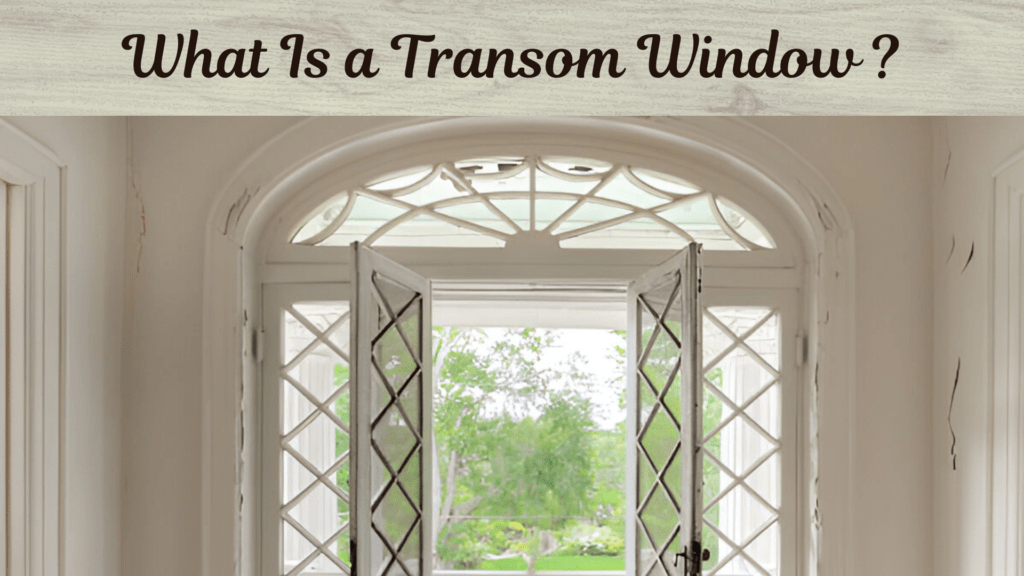Transom windows are among the most elegant and functional features in both classic and modern architecture. Their unique position and styling can boost aesthetic appeal, increase natural light, and even improve ventilation in your home.
In this detailed guide, you’ll learn exactly what a transom window is, its historical roots, types and design options, benefits, considerations, and answers to common questions.

What Is a Transom Window?
A transom window is a small window placed above a door or another window. It is separated by a horizontal beam called a “transom.” In the past, these windows were used to let light and air into a room while still keeping it private and safe. Today, people like them for both their looks and usefulness.
Where It’s Found: Always above a door or window
Common Shapes: Rectangle, half-circle (called a fanlight), square, or other special shapes
Types: Some can open to let in air, while others are fixed and don’t open.
A Short History of Transom Windows
Transom windows have been used since the 1300s in Europe. Back then, they helped bring in light and fresh air before people had electricity or air conditioning.
Gothic and Victorian times: These windows became very fancy, often with colored glass, metal designs, or fan shapes.
In the U.S.: Styles like Federal and Neoclassical used beautiful curved transom windows—some famous buildings like the White House have them.
Modern homes: People still use transom windows to make homes look classic, add style, or bring in more natural light.
How Do Transom Windows Work ?
Historically, transom windows were built to open with hinges or mechanisms (such as rods or chains). This allowed:
Cross-ventilation: Air moved freely between rooms while doors remained closed.
Light enhancement: Even with closed doors, rooms received daylight from outside.
While most modern transom windows are fixed for simplicity and energy efficiency, operable versions are available for those who value traditional features and improved airflow.
Types and Styles of Transom Windows
| Type/Style | Description | Typical Use |
| Rectangular | Straight lines, matches width of door or window below | Modern, Craftsman, Colonial |
| Semicircular (Fanlight) | Arched or fanned shape, often with divided panes | Georgian, Victorian |
| Fixed | Does not open; purely decorative and for natural light | Exterior or interior walls |
| Operable | Can open to allow airflow, often with hinges or tilt hardware | Historical restorations |
| Custom/Geometric | Unusual shapes—oval, triangular, etc.—for unique design impact | Contemporary, custom homes |
Materials: Wood, vinyl, aluminum, fiberglass
Glass options: Clear, frosted, stained, textured
Benefits of Transom Windows
1. Increased Natural Light
Transom windows can transform a dim space by inviting in extra sunlight. Placed high above eye-level, they illuminate hallways, foyers, and interior rooms without sacrificing privacy.
2. Enhanced Airflow
Operable transom windows are perfect for promoting fresh air movement, especially in bathrooms, bedrooms, or historic homes where cross-ventilation matters.
3. Aesthetic and Architectural Appeal
- Adds visual height, making rooms feel more spacious.
- Provides classic and modern style, depending on shape and materials.
- Enhances curb appeal, contributing to higher property value.
4. Flexibility and Versatility
Transom windows fit a variety of spaces:
- Above entry doors for a dramatic entryway.
- Interior rooms for light-sharing between spaces.
- Above garage doors or patio doors for consistency and decorative effect.
5. Energy Savings
By maximizing daylight, these windows can reduce the need for artificial lighting during the daytime. Some energy-efficient models use insulated glazing to further improve thermal performance.
Things to Consider Before Installing a Transom Window
Hard to Add Later: Installing a transom window above an existing door or wall can be tricky. It may need changes to the structure, so you’ll likely need a professional to do it.
Airflow Depends on the Type: Only transom windows that open can let in fresh air. Most newer ones don’t open, so they’re only for light and decoration.
Harder to Clean: Since transom windows are placed high up, it can be difficult to reach them for cleaning or repairs.
Energy Efficiency: If the window isn’t sealed well or has poor insulation, it might let heat in or out, which could raise your energy bills a little.
Where Are Transom Windows Used ?
Entryways: Above front or back doors for dramatic effect and natural light.
Interior Doors: Sharing light between adjacent rooms or hallways.
Bathroom Walls: Bringing daylight in while keeping privacy.
Living Spaces: Over large windows or French doors to expand a view upward.
Historic Restorations: Breaking up tall wall spaces and reviving original details.
Also read:
Shou Sugi Ban: Explained in Detail
Is a Skillion Roof Right for You ?
Frequently Asked Questions (FAQs)
1. Are transom windows only for historic homes?
No. While transom windows are iconic in older homes, they fit beautifully in contemporary designs—from minimalist rectangular panels to bold geometric shapes.
2. Can transom windows open?
Some transom windows are operable and can open for airflow, but most modern installations are fixed (sealed shut) to prioritize insulation and energy efficiency.
3. What sizes and shapes do they come in?
Transom windows come in many sizes. They can be as short as a few inches or as tall as a few feet. You can even have them custom-made to match your style. The most common shapes are rectangles, arches, and fanlight (half-circle) designs.
4. Are transom windows energy-efficient?
Yes, if you choose well-insulated, double- or triple-glazed units. They add daylight, helping reduce electricity use, but very old or single-pane models could result in heat loss.
5. Do they compromise privacy?
Not typically—because they are placed high above doors or windows, people cannot see through them easily. Frosted or textured glass can also be used for additional privacy.
6. What’s the difference between a transom window and a sidelight?
A transom window sits above a door or window, while a sidelight is a vertical, narrow window that flanks a door or window on one or both sides.
7. Can I add a transom window to my existing home?
In most cases, yes—a professional contractor can cut and frame a new transom window above a suitable door or window. However, major structural changes may be needed, so professional assessment is recommended.
Final Thoughts
Transom windows are a classic and flexible design choice that look great and serve a purpose. Whether you’re fixing up an old house, building a new one, or just want to let in more sunlight, these stylish windows are a great option.
With so many shapes, styles, and materials to choose from, it’s easy to find one that fits your home. Just make sure to think about what your home needs, what style you like, and talk to a professional to help you get the best results from this beautiful feature.

